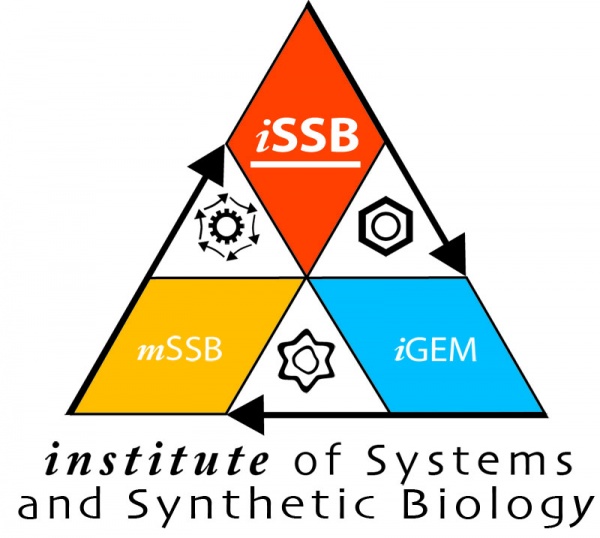Team:Evry/Pill design
From 2013.igem.org
| Line 309: | Line 309: | ||
<div style="clear: both;"></div> | <div style="clear: both;"></div> | ||
| + | <div class="captionedPicture" style="width:30%;float:left"> | ||
| + | <a title="Capsule integrity 15 minutes" href="https://static.igem.org/mediawiki/2013/5/58/091_25pc.jpg"> | ||
| + | <img alt="Capsule integrity 15 minutes" src="https://static.igem.org/mediawiki/2013/5/58/091_25pc.jpg" class="Picture"/> | ||
| + | </a> | ||
| + | <div class="caption"> | ||
| + | <b>Figure 18:</b> Capsule dissolvement stage after 15 minutes of exposure to PBS buffer (pH = 7,2). | ||
| + | </div> | ||
| + | </div> | ||
| + | |||
| + | <div class="captionedPicture" style="width:30%;float:left"> | ||
| + | <a title="Turbidity integrity 15 minutes" href="https://static.igem.org/mediawiki/2013/e/e9/090_25pc.jpg"> | ||
| + | <img alt="Turbidity integrity 15 minutes" src="https://static.igem.org/mediawiki/2013/e/e9/090_25pc.jpg" class="Picture"/> | ||
| + | </a> | ||
| + | <div class="caption"> | ||
| + | <b>Figure 19:</b> Water turbidity after 15 minutes of exposure to PBS buffer (pH = 7,2). | ||
| + | </div> | ||
| + | </div> | ||
| + | |||
| + | <p style="padding-top:1%;"> | ||
| + | We observe that after two hours of exposure to gastric acidity, the capsule are still not dissolved. They kept their integrity (figure 13) and didn't deliver its contanment (figure 14). | ||
| + | <div style="clear: both;"></div> | ||
| + | |||
| + | <div class="captionedPicture" style="width:30%;float:left"> | ||
| + | <a title="Capsule integrity 30 minutes" href="https://static.igem.org/mediawiki/2013/0/02/096_25pc.jpg"> | ||
| + | <img alt="Capsule integrity 30 minutes" src="https://static.igem.org/mediawiki/2013/0/02/096_25pc.jpg" class="Picture"/> | ||
| + | </a> | ||
| + | <div class="caption"> | ||
| + | <b>Figure 20:</b> Capsule dissolvement stage after 30 minutes of exposure to PBS buffer (pH = 7,2). | ||
| + | </div> | ||
| + | </div> | ||
| + | |||
| + | <div class="captionedPicture" style="width:30%;float:left"> | ||
| + | <a title="Turbidity integrity 30 minutes" href="https://static.igem.org/mediawiki/2013/a/a6/095_25pc.jpg"> | ||
| + | <img alt="Turbidity integrity 30 minutes" src="https://static.igem.org/mediawiki/2013/a/a6/095_25pc.jpg" class="Picture"/> | ||
| + | </a> | ||
| + | <div class="caption"> | ||
| + | <b>Figure 21:</b> Water turbidity after 30 minutes of exposure to PBS buffer (pH = 7,2). | ||
| + | </div> | ||
| + | </div> | ||
| + | |||
| + | <p style="padding-top:1%;"> | ||
| + | We observe that after two hours of exposure to gastric acidity, the capsule are still not dissolved. They kept their integrity (figure 13) and didn't deliver its contanment (figure 14). | ||
| + | <div style="clear: both;"></div> | ||
| + | |||
| + | <div class="captionedPicture" style="width:30%;float:left"> | ||
| + | <a title="Capsule integrity 40 minutes" href="https://static.igem.org/mediawiki/2013/b/bf/098_25pc.jpg"> | ||
| + | <img alt="Capsule integrity 40 minutes" src="https://static.igem.org/mediawiki/2013/b/bf/098_25pc.jpg" class="Picture"/> | ||
| + | </a> | ||
| + | <div class="caption"> | ||
| + | <b>Figure 22:</b> Capsule dissolvement stage after 40 minutes of exposure to PBS buffer (pH = 7,2). | ||
| + | </div> | ||
| + | </div> | ||
| + | |||
| + | <div class="captionedPicture" style="width:30%;float:left"> | ||
| + | <a title="Turbidity integrity 40 minutes" href="https://static.igem.org/mediawiki/2013/e/e7/097_25pc.jpg"> | ||
| + | <img alt="Turbidity integrity 40 minutes" src="https://static.igem.org/mediawiki/2013/e/e7/097_25pc.jpg" class="Picture"/> | ||
| + | </a> | ||
| + | <div class="caption"> | ||
| + | <b>Figure 23:</b> Water turbidity after 40 minutes of exposure to PBS buffer (pH = 7,2). | ||
| + | </div> | ||
| + | </div> | ||
| + | |||
| + | <p style="padding-top:1%;"> | ||
| + | We observe that after two hours of exposure to gastric acidity, the capsule are still not dissolved. They kept their integrity (figure 13) and didn't deliver its contanment (figure 14). | ||
| + | <div style="clear: both;"></div> | ||
| + | |||
| + | <div class="captionedPicture" style="width:30%;float:left"> | ||
| + | <a title="Capsule integrity 0 minute" href="https://static.igem.org/mediawiki/2013/c/ce/086_25pc.jpg"> | ||
| + | <img alt="Capsule integrity 0 minute" src="https://static.igem.org/mediawiki/2013/c/ce/086_25pc.jpg" class="Picture"/> | ||
| + | </a> | ||
| + | <div class="caption"> | ||
| + | <b>Figure 16:</b> Capsule dissolvement stage after 0 minute of exposure to PBS buffer (pH = 7,2). | ||
| + | </div> | ||
| + | </div> | ||
| + | |||
| + | <div class="captionedPicture" style="width:30%;float:left"> | ||
| + | <a title="Turbidity integrity 0 minute" href="https://static.igem.org/mediawiki/2013/a/ac/088_25pc.jpg"> | ||
| + | <img alt="Turbidity integrity 0 minute" src="https://static.igem.org/mediawiki/2013/a/ac/088_25pc.jpg" class="Picture"/> | ||
| + | </a> | ||
| + | <div class="caption"> | ||
| + | <b>Figure 17:</b> Water turbidity after 0 minute of exposure to PBS buffer (pH = 7,2). | ||
| + | </div> | ||
| + | </div> | ||
| + | |||
| + | <p style="padding-top:1%;"> | ||
| + | We observe that after two hours of exposure to gastric acidity, the capsule are still not dissolved. They kept their integrity (figure 13) and didn't deliver its contanment (figure 14). | ||
| + | <div style="clear: both;"></div> | ||
| + | |||
| + | <div class="captionedPicture" style="width:30%;float:left"> | ||
| + | <a title="Capsule integrity 0 minute" href="https://static.igem.org/mediawiki/2013/c/ce/086_25pc.jpg"> | ||
| + | <img alt="Capsule integrity 0 minute" src="https://static.igem.org/mediawiki/2013/c/ce/086_25pc.jpg" class="Picture"/> | ||
| + | </a> | ||
| + | <div class="caption"> | ||
| + | <b>Figure 16:</b> Capsule dissolvement stage after 0 minute of exposure to PBS buffer (pH = 7,2). | ||
| + | </div> | ||
| + | </div> | ||
| + | |||
| + | <div class="captionedPicture" style="width:30%;float:left"> | ||
| + | <a title="Turbidity integrity 0 minute" href="https://static.igem.org/mediawiki/2013/a/ac/088_25pc.jpg"> | ||
| + | <img alt="Turbidity integrity 0 minute" src="https://static.igem.org/mediawiki/2013/a/ac/088_25pc.jpg" class="Picture"/> | ||
| + | </a> | ||
| + | <div class="caption"> | ||
| + | <b>Figure 17:</b> Water turbidity after 0 minute of exposure to PBS buffer (pH = 7,2). | ||
| + | </div> | ||
| + | </div> | ||
| + | |||
| + | <p style="padding-top:1%;"> | ||
| + | We observe that after two hours of exposure to gastric acidity, the capsule are still not dissolved. They kept their integrity (figure 13) and didn't deliver its contanment (figure 14). | ||
| + | <div style="clear: both;"></div> | ||
Revision as of 23:44, 3 October 2013
Capsule design

Abstract
For an optimum efficiency of our iron chelating bacteria, the purpose is to enhance its growth at the distal area of the duodenum and the proximal area of the jejunum. To target this region, we designed a capsule suited for bacteria delivery and improved its galenic formulation to optimize growth.
Our first step was to create a novel capsule following the actual norms from the European Pharmacopeoa concerning gastro-enteric resistant formulations.
In a second step, our goal is to make the bacteria survive right after the dissolution tests of our capsule.
Posology
For a treatment based on bacteria as an medically active entity, we thought of the posology of such a capsule. The patient has to take the capsule on an empty stomach. Thus, beside reducing the exposure to gastric acidity, it also gives the bacteria enough time to grow once delivered in the duodenum and jejunum. Our strategy focuses on preparing the duodenum of the patient for the next meal and let the bacteria sufficient time to settle and produce sufficient chelators to reduce the iron absorption.
Barriers to overcome and conditions to fulfill
The challenge here is double. First, we need to overcome the acidity of the stomach which is lethal for most living forms. Secondly, our capsule must dissolve right in the duodenum to deliver the containment at the distal duodenum and the proximal jejunum. Additionnally, we added HPMC (Hydroxypropylmethylcellulose) among the components for the capsule design to optimize bacterial growth. More in detail, right after the split into the duodenum, the obstruction caused by the HPMC in contact of water has been evaluated to have the right viscosity to allow a stagnant growth of the bacteria and also the passage of food.
Design of the capsule, step by step

Which galenic formulation suits the best our purpose?
The first step in the design of our pill is to determine its galenic formulation. We want a per os administration for our bacteria and had the choice between either a tablet or a capsule. A tablet not only requires a heavy and dry compression but also the bacteria in a lyophilized form. This last step consists of extreme variations of temperature and pression which are not favorable for living beings. However, the capsule is more suited for our purpose because it offers the possibility to contain a non-compressed powder and avoids a lyophilization step, thus representing a softer environment for bacteria transport. Additionnaly, lyophilized bacteria have a delayed recovery before starting any metabolic activity in comparison to a dessicated form.

How to store the bacteria in the capsule?
The design of a capsule requires every component to be in a powder form. Thus, we tested which one was able to absorb the most LB medium saturated with bacteria. In galenic research, this is called a moisture absorbent and has the right chemical properties to keep our drug (here our bacteria in LB medium) in a dry environment. We experimented
For the next step, we want to increase the volume to 35 mL which is the sufficient amount to make 50 capsules (standard for one rack, figure 3). Thus, a diluent is required and we opted for HPMC (hydroxypropylmethylcellulose). The entire volume of powder has to be equally distributed in the capsules (figure 4).
Finally, the 50 capsules contain all together 11 ml of colloidal silica (where 4 mL of saturated bacteria have been dissolved in) and 24 mL of HPMC. The last step is the closing of the capsules (figure 5 and 6).

How to overcome the acidity of the stomach?
It is very common in the pharmaceutical world, and more precisely in galenical research, to overcome the acidity of the stomach and to target the duodenum/jejunum for the delivery of the capsule. By a simple saoking of one side of the capsule in an ethanol-based solution of methacrylic acid and followed by a drying process (hot air), we managed to surround our capsule with a double-enveloppe resistant that confers resistance to gastric acidity. The capsule has to resist as long as possible to the gastric content, but not to much otherwise we miss its dissolution in the duodenum.

How to deliver the bacteria in the jejunum?
The delivery in the duodenum/jejunum is already possible due to the gelatine-based composition of the capsule. In contact to water, the capsule dissolves and delivers its containment in the duodenum. This is only feasable when the capsule has already resisted to the gastric acidity. Moreover, we added a HPMC as a diulent. In the presence of water, right after the dissolution of the gelatine capsule, it is able to swell. Depending on its density, the polymere forms a more or less viscuous obstruction. This process creates an environment in the jejunum where bacteria can statically proliferate. Thus, HPMC, beside its properties as a diluent, is also called a bio-adhesive for its ability to stick to the membranes of the intestins and form an obstruction.

How to prove the real efficiency of our capsule?
As a proof of concept, we fulfilled the two basic requirements of the European Pharmacopeia to make a gastro-enteric resistant capsule which are as follows:
- No dissolution of the capsule after 2 hours of exposure to gastric acid (solution at pH = 2)
- Dissolution of the capsule within 1 hour of exposure to water (Phosphate Buffer solution, pH = 7) right afterwards
The dissolution machine is able to lift a basket up and down into a 800mL beaker (figure 9). For every experience, we were able to test 6 capsules spread into 6 apart columns (figure 10). Keep in mind that these columns have the possibility to be closed by a lid on the top to increase the dissolution and mimic different segments of the intestins.
We observe that after one hour of exposure to gastric acidity, the capsules are not dissolved. They kept their integrity (figure 11) and didn't deliver its contanment (figure 12).
We observe that after two hours of exposure to gastric acidity, the capsule are still not dissolved. They kept their integrity (figure 13) and didn't deliver its contanment (figure 14).
We observe that the water is very clear (figure 15), thus meaning that the first condition of the European Pharmacopeoa to create a gastro-enteric resistant capsule is fullfilled.
We observe that after two hours of exposure to gastric acidity, the capsule are still not dissolved. They kept their integrity (figure 13) and didn't deliver its contanment (figure 14).
We observe that after two hours of exposure to gastric acidity, the capsule are still not dissolved. They kept their integrity (figure 13) and didn't deliver its contanment (figure 14).
We observe that after two hours of exposure to gastric acidity, the capsule are still not dissolved. They kept their integrity (figure 13) and didn't deliver its contanment (figure 14).
We observe that after two hours of exposure to gastric acidity, the capsule are still not dissolved. They kept their integrity (figure 13) and didn't deliver its contanment (figure 14).
We observe that after two hours of exposure to gastric acidity, the capsule are still not dissolved. They kept their integrity (figure 13) and didn't deliver its contanment (figure 14).
We observe that after two hours of exposure to gastric acidity, the capsule are still not dissolved. They kept their integrity (figure 13) and didn't deliver its contanment (figure 14).
 "
"




































